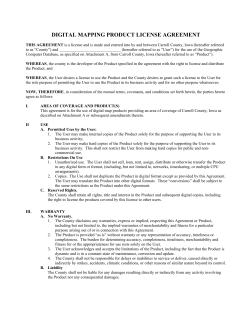
Document 244179
Why collaboratives work Dr Shawn Sturland National Clinical Lead Collaborative to reduce central line associated bacteraemia •6th September 2012 Why collaboratives work Why collaboratives work Collaboration is working together to achieve a goal. It is a recursive process where two or more people or organizations work together to realize shared goals, (this is more than the intersection of common goals seen in cooperative ventures, but a deep, collective, determination to reach an identical objective — for example, an intriguing endeavour that is creative in nature— by sharing knowledge, learning and building consensus. Most collaboration requires leadership, although the form of leadership is social within a decentralized and egalitarian group. Why collaboratives work •Deal with complex systems (cf simple processes...) •Unique structural and functional attributes •Process vs content (CLAB as an example) Why collaboratives work •Structure - a complex structure arising from the application of simple rules. •Recursive (contextual) •Egalitarian •Distributed leadership Why collaboratives work •Structure - a complex structure arising from the application of simple rules. •Recursive (contextual) •Egalitarian •Rapid initiation •Asymmetric progress Why collaboratives work •Structure - a complex structure arising from the application of simple rules. •Distributed leadership – grassroots momentum and context •“Process” control comes from the “vertical core” steering group (critical!) •Must start at the absolute top (validity and endorsement) •Dynamic – moves from coaching to facilitation and moderation (learning sessions..) •“Supported by the model. Connected by the model” •“Content” control is from expert group Why collaboratives work •Function •Collaboratives generate institutional isomorphic pressures (at all levels) •Normative •Mimetic •Coercive Why collaboratives work •Function •Collaboratives generate natural networked communities •Along horizontal lines of connection and engagement (fracing) •Disrespect formal cultural structures (emergence..) •Social control is inbuilt (respect – expectation based – etc) •The result is “a sense of community” Why collaboratives work •Function •Collaboratives culturally reframe issues as “a social problem with a solution” •Behavioral, avoidable and harmful to the innocent (victim group) •Personalized, based on qualitative story telling •The result in social “organic” solidarity (as opposed to mechanical) against the issue Why collaboratives work •Function •Collaboratives allow multiple interventions that function in different ways to change practice •Empowers everybody (resets norms and rituals) •Puts the patient in the centre of care. (value congruity) Why collaboratives work •Function •Collaboratives use data as a disciplinary force. (Limited) disclosure demonstrates •Is there a problem? •How big is the problem? •Look how we solved the problem •Is the problem under control? Why collaboratives work •Function •Collaboratives Skillfully use “hard edges” without formal supervision •Checklist acts as a latent supervisor •Rewards for membership •Sanctions for lagging •Enables the wider society (call centre!) •A database external to the facility enhances validation. Why collaboratives work Complex adaptive systems are special cases of complex systems, often defined as a 'complex macroscopic collection' of relatively 'similar and partially connected micro-structures' – formed in order to adapt to the changing environment, and increase its survivability as a macro-structure. They are complex; in that they are dynamic networks of interactions, and their relationships are not aggregations of the individual static entities. They are adaptive; in that the individual and collective behaviour mutate and selforganize corresponding to the change-provoking micro-event or collection of events. Why collaboratives work
© Copyright 2025












